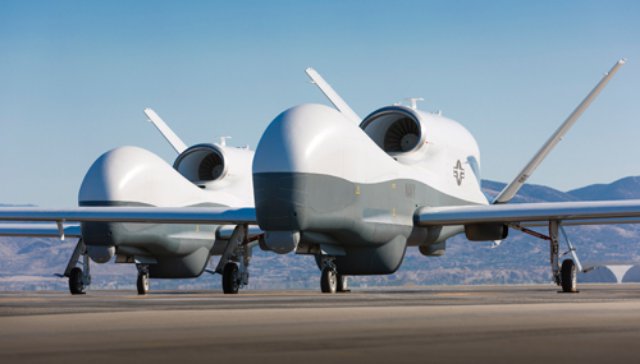The U.S. Navy is moving ahead with plans to kick off a series of tests in Guam this summer of its MQ-4C Triton autonomous signals-intelligence aircraft, a service official said April 4.
The Northrop Grumman-built aircraft recently completed a preliminary design review and a successful first flight of an improved software suite which will enable “early operational capability” deployment for the aircraft’s baseline sensor suite, Sean Burke, PMA 262 program manager for U.S. Navy Naval Air Systems Command, told reporters at the Navy League’s annual Sea-Air-Space conference in National Harbor, Maryland.
The suite includes radar and electronic support measures, an automatic identification system and electro-optimal infrared sensors, he added. The successful tests allowed Northrop Grumman to proceed with its plan to install a multi-intelligence suite of sensors on all Triton aircraft moving forward, with initial operational capability set for fiscal year 2021.
The Triton will replace the service’s EP-3 Aries II signals reconnaissance aircraft. The unmanned aircraft is intended to be compatible with Boeing’s P-8, as well as the Lockheed Martin-built P-3, Burke said. The Navy is moving to replace its P-3 Orion anti-submarine maritime surveillance aircraft with the P-8 Poseidon multi-mission turboprop.
“We’ve now moved to where we add a signals intelligence capability to the Triton,” he said. “We will do that in the first primary upgrade with what we’re calling the Triton multi-int, so that we can retire the EP-3s.”
The Triton provides 24/7 coverage of its area of responsibility, flying at 56,000 feet and capable of dip maneuvers to see underneath cloud coverage, said Doug Shaffer, vice president of Triton programs at Northrop Grumman. It is an all-weather system, with anti-icing and anti-lightning capabilities and a Rolls Royce-developed engine, he added.
“It really puts these platforms in reaches that maritime hasn’t had in the past,” he noted.
Northrop Grumman is working to get the aircraft to initial operating capability by 2020, before the EP-3 fleet is set to retire starting in 2021, Burke said.
Two Triton aircraft are being delivered with the baseline software suite this summer to Naval Base Guam, he said.
The company will continue to test the upgraded signals intelligence sensors. Northrop Grumman is currently set to deliver 68 aircraft, according to the Navy’s program of record. It expects to complete a preliminary design review in 2021, he noted.
Though Burke declined to comment on whether the new sensors would be installed on P-8 aircraft or similar maritime surveillance aircraft, he said: “It’s called the common SIGINT payload, so the name could help define other opportunities.
”Northrop also plans to test a sense-and-avoid radar system that could help the Navy avoid mid-air collisions and other possible issues in flight. That will be included in the following set of integrated functional capability testing, expected to occur in 2025, after the aircraft are planned to be delivered to the service, Burke said.“We said we wanted to deliver the multi-int capability on time. If you try to put the sense-and-avoid radar in there as well, that pushes out that timeline and that’s not acceptable,” he said.
The radar requires a higher degree of test and certification requirements, “so when we looked at trying to pack all of that into the IFC timeline, it was too much complexity and too much content,” he added, noting that funding is always a concern as well.
Once delivered, the Triton will be stationed at several bases around the world, including: Sigonella, Italy; Pax River, Maryland; Mayport, Florida; and Fort Whidbey Island in Washington. Two main operating bases will be located in Point Mugu, California, and in Guam, Burke said.

